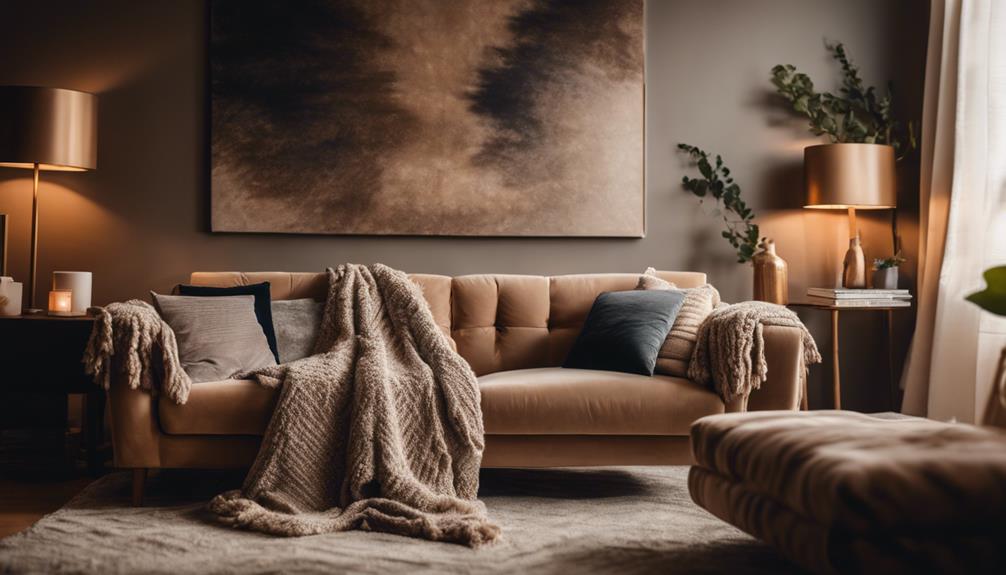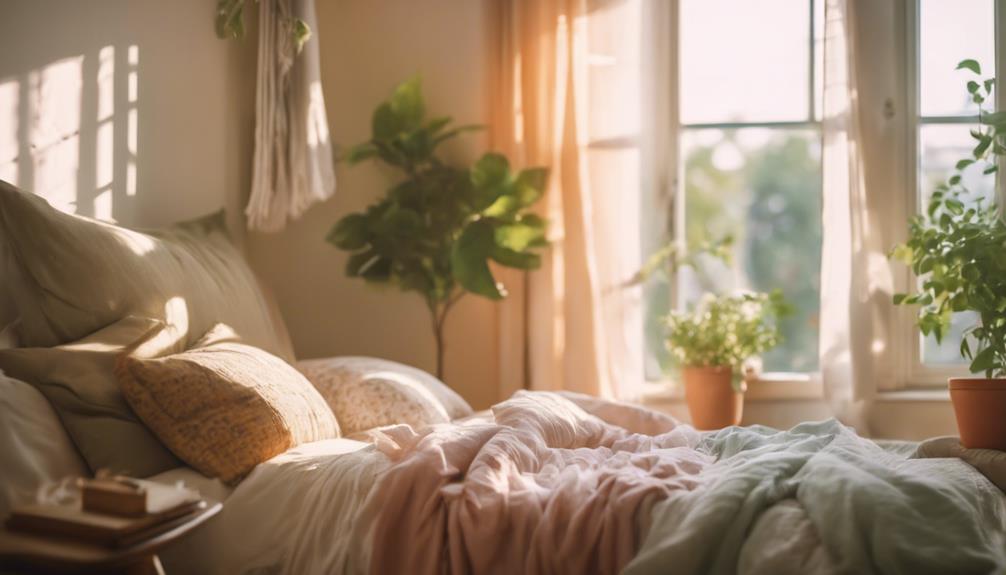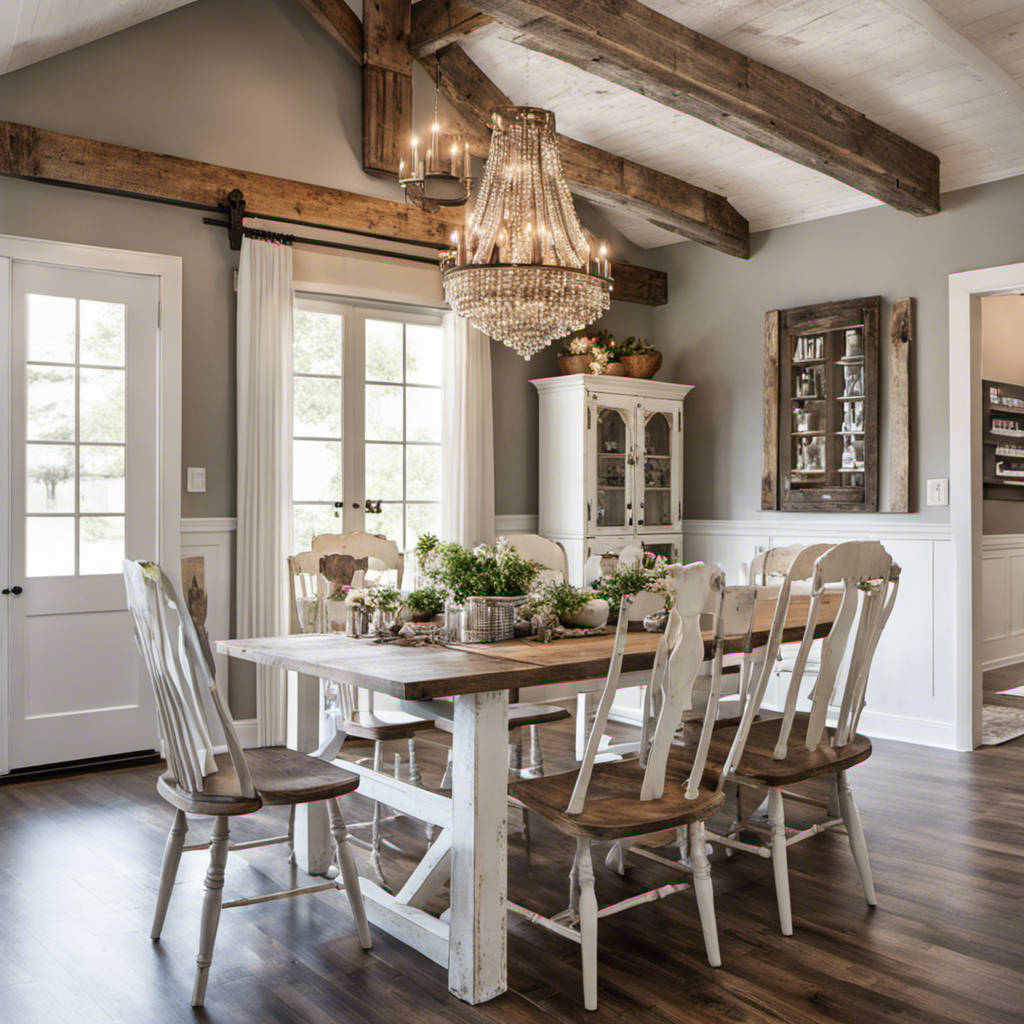You can instantly add depth to any room with simple texture tips that elevate your space. Start by mixing different materials, like plush textiles with harder surfaces, to create balance and interest. Incorporating natural elements, such as plants or reclaimed wood, introduces warmth and organic appeal. Layer your textiles—think chunky blankets over soft pillows—and experiment with various patterns to enhance visual intrigue. Don't forget to play with colors and tones for a harmonious atmosphere. By implementing these strategies, your room can feel more inviting and engaging. Stick around to discover even more ways to enhance your space!
Key Takeaways
- Mix smooth and rough textures to create visual interest and a dynamic atmosphere in your space.
- Layer various textiles, such as lightweight and chunky materials, to enhance warmth and define areas.
- Incorporate textured finishes like plaster or wallpaper to add depth and character to your walls.
- Utilize a tonal color scheme with varying shades and materials for a harmonious yet complex look.
Understanding Texture in Design
Understanding texture in design is vital because it adds depth and interest, transforming a flat space into an inviting environment.
When you consider the texture of various materials, you'll notice how they can considerably impact the overall feel of a room. A smooth surface might evoke a sense of calm, while a rougher texture can create visual interest and stimulate the senses.
Incorporating different textures is essential for making a room feel dynamic. For instance, mixing soft textiles like plush cushions with harder materials such as wood or metal not only creates a balanced aesthetic but also enhances the depth of your space.
Think about how flooring options, wall finishes, and furnishings can contribute to the overall texture.
Benefits of Mixed Textiles
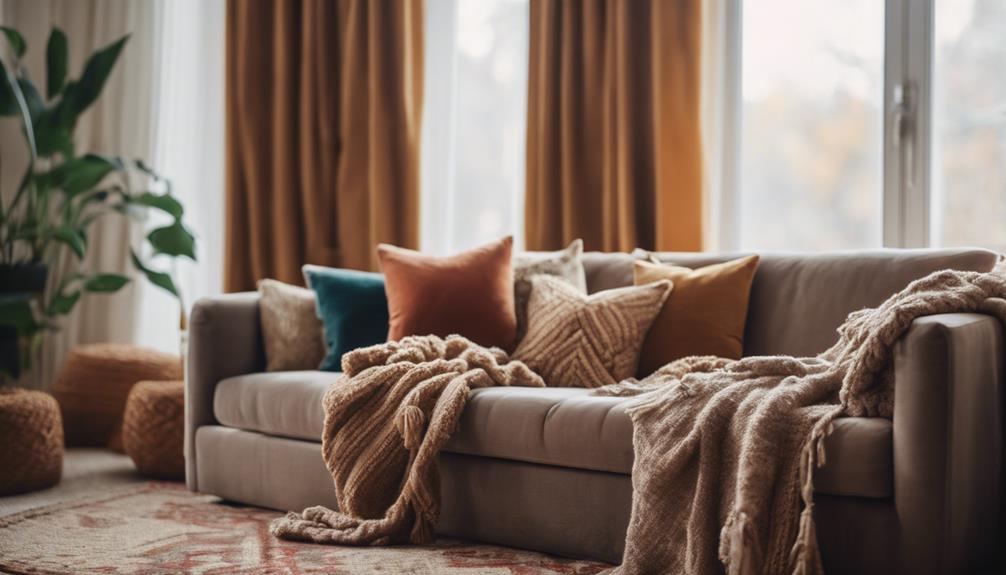
Why settle for a single texture when mixing textiles can instantly elevate your space with warmth and visual appeal? By incorporating different textures, like leather, velvet, and cotton, you create a rich, layered look that adds depth and makes your room feel inviting.
Think about how throw pillows and bedding can transform your aesthetic; using a variety of fabric types enhances comfort while also adding visual interest.
Layering different textiles—like coarse jute rugs paired with soft wool blankets—helps define areas in open floor plans, promoting a cozy atmosphere. The combination of lightweight linen curtains with chunky knit throws not only boosts visual complexity but also enhances the tactile experience in your space.
A well-curated mix of textiles evokes emotional responses, making your home feel more personalized and engaging for both you and your guests.
Choosing Finishes and Materials
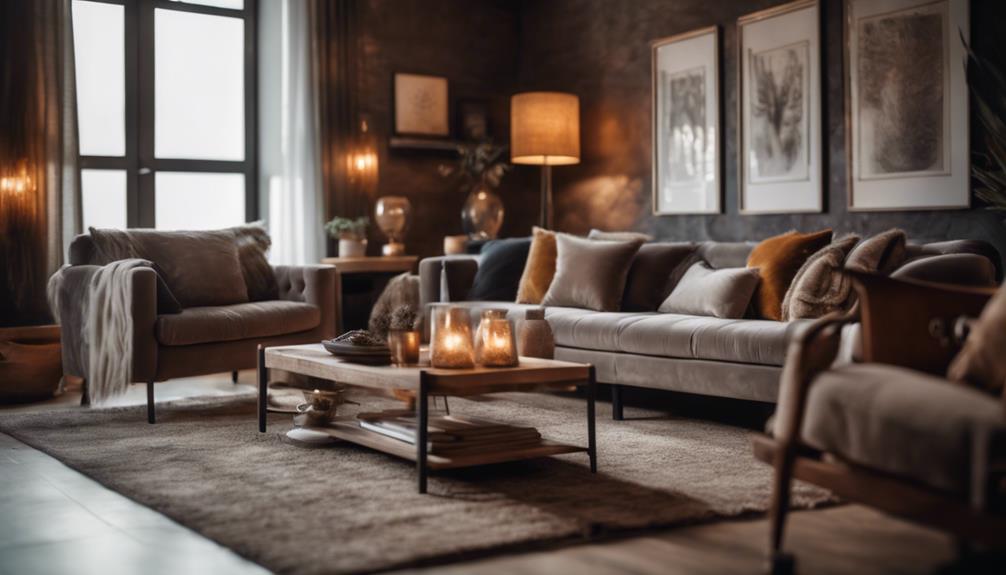
Choosing the right finishes and materials can transform your space, adding depth and character that flat surfaces simply can't achieve.
When you start choosing textured finishes, consider options like plaster or wallpaper, which can greatly enhance visual texture compared to standard painted walls. You can also experiment by pairing shiny materials, such as glass or metal fixtures, with matte elements like wood or fabric. This balance creates a dynamic aesthetic and adds dimension to any room.
Incorporating different materials, like textured tiles or stone sinks, not only adds character but also creates focal points that draw the eye.
Don't forget to highlight original architectural features, such as exposed beams or brick walls. Blending these with modern accents fosters a harmonious textural dialogue, rejuvenating your overall design.
Exploring a Tonal Look
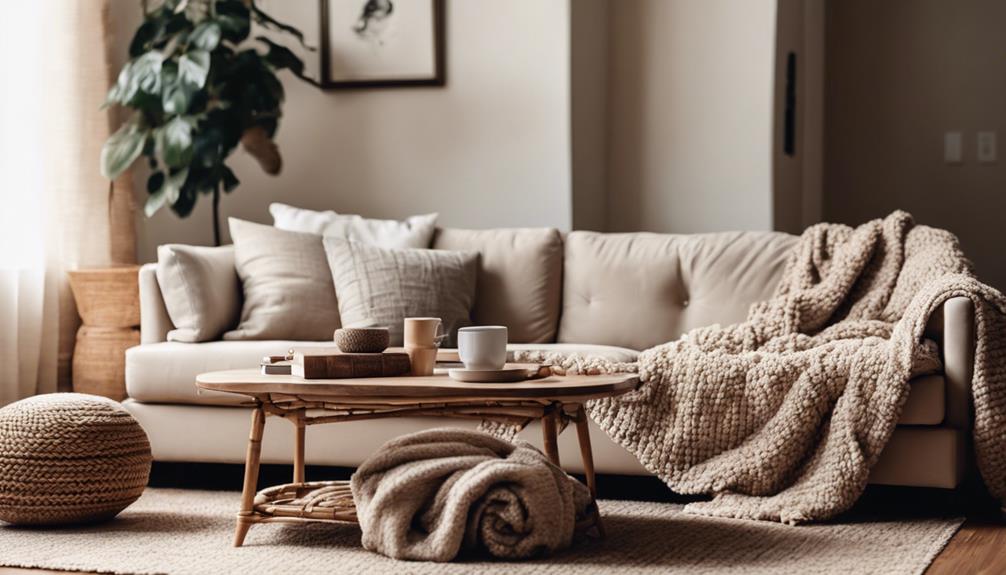
Exploring a tonal look can elevate your space by seamlessly blending multiple shades of a single color, creating depth and a soothing atmosphere. By using various whites, creams, or light grays, you can achieve subtlety while maintaining a cohesive design.
To enhance this tonal look, focus on incorporating different materials. Mixing textiles like linen, silk, and wool adds richness and variation, enriching your space without overwhelming it. Layering throw pillows and blankets in diverse shades not only creates visual intrigue but also adds comfort and warmth.
Don't shy away from introducing metallic and natural elements as accents; these can enhance texture and provide visual interest against the backdrop of neutral tones. A well-executed tonal scheme promotes a harmonious atmosphere, allowing you to explore complexity through texture while keeping the overall aesthetic serene and inviting.
Mixing Color and Pattern
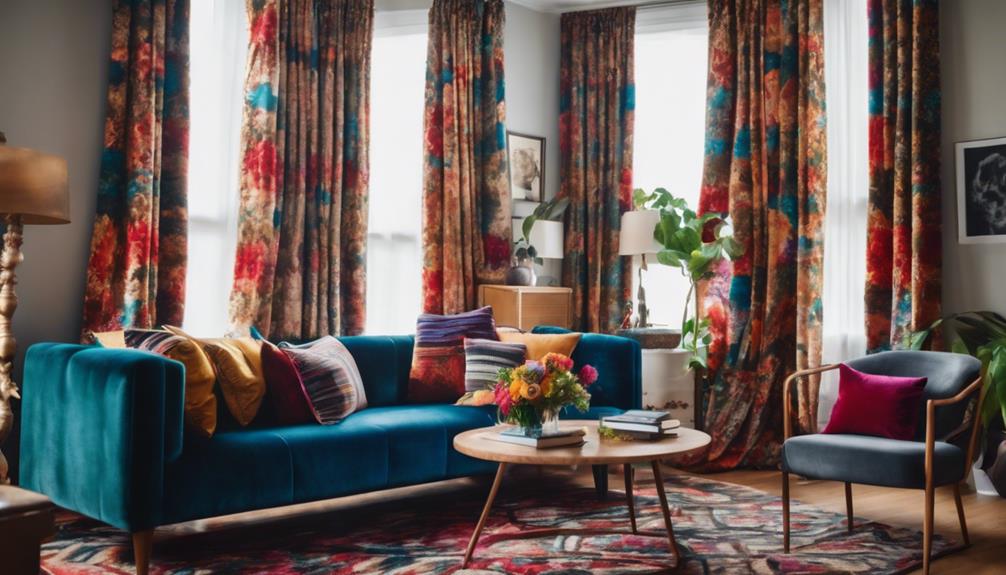
Mixing color and pattern can transform your space into a vibrant and engaging environment.
You can use techniques like blending different patterns within a cohesive palette or opting for a monochromatic approach to elevate textural interest.
Visual Stimulation Techniques
Combining various patterns like stripes, plaid, and florals within a cohesive color palette not only enhances visual stimulation but also brings a harmonious flow to your space. You can easily mix and match different decor pieces to add texture to a room, creating depth and dimension that makes your room design truly enchanting.
Here's a quick guide to help you visualize the impact of mixing patterns:
| Pattern Type | Effect |
|---|---|
| Stripes | Creates an illusion of height and width |
| Plaid | Adds warmth and a sense of coziness |
| Florals | Introduces a lively and inviting atmosphere |
Choosing various shades within the same color family guarantees that your design remains cohesive while still providing visual interest. For instance, a velvet sofa paired with matte walls and glossy accents not only adds texture but also creates striking contrasts that enrich the overall aesthetic. Layering different materials and sculptural decor can elevate the dimensionality of your space, making it feel more engaging and inviting. So go ahead, experiment with patterns and colors to create a room that reflects your unique style!
Monochromatic Textural Variations
A monochromatic color scheme can transform your space by utilizing various textures and materials, enhancing depth while keeping a cohesive aesthetic. By incorporating multiple shades of the same color—like light gray, charcoal, and silver—you can create a rich, layered effect that adds visual interest without detracting from the overall theme.
Pair a matte wall with glossy accent pieces, such as a sleek sofa or metallic decor, to introduce subtle contrasts that heighten the texture throughout the room. Don't forget to mix textiles too; adding throw pillows and rugs in similar hues allows you to play with patterns while maintaining the monochromatic vibe.
Consider using a variety of materials like linen, silk, and wool to infuse warmth and complexity into your design. These textiles can work together to create a tactile experience, making your space feel inviting and sophisticated.
Layering Sculptural Elements
Layering sculptural elements in your decor not only creates striking focal points but also enhances the overall textural variety of your space. Start by incorporating unique pieces like vases or abstract sculptures that draw the eye and introduce visual interest. Mixing colors and patterns through these sculptural elements—think patterned ceramics or colorful metal art—can stimulate the senses while keeping a cohesive palette.
When layering, consider varying heights and shapes. Pair a tall vase with shorter, chunkier pieces to add dimension to tabletops or shelves. This interplay of different sizes creates depth and keeps the arrangement dynamic. Using contrasting materials, such as a sleek glass sculpture alongside a rough-hewn wooden piece, enriches the design by showcasing diverse textures.
As you're arranging your sculptural elements, aim for groups of three or five. Varying sizes and finishes within these clusters not only creates harmony but also enhances your room's overall depth. This thoughtful layering of sculptural elements can transform a simple space into a visually engaging haven, inviting admiration and conversation.
Enhancing With Wall Art

Wall art can transform a room by adding texture and visual intrigue through a variety of mediums like framed prints, sculptures, and textiles. When you incorporate texture into your wall design, you create a space that feels rich and inviting.
A gallery wall is an excellent way to showcase different pieces, allowing you to mix artwork and photographs. This dynamic display adds layers and depth, making the wall a focal point in your room.
Textured wall art, such as woven hangings or 3D sculptures, introduces tactile elements that soften hard surfaces and contribute to the ambiance. You can play with varying textures to enhance the visual interest of your space.
Don't hesitate to integrate unexpected elements, like fabric swatches or wallpaper samples, into your arrangements; these additions can make your display more engaging and unique.
Combining Old and New

Mixing vintage and contemporary pieces can breathe new life into your space, creating an enchanting contrast that enhances its character. This blend of different styles not only adds visual interest but also introduces varied textures to a room.
Consider pairing a sleek leather chair with a rustic wooden coffee table; this juxtaposition captures the essence of both old and new, making your design feel curated and intentional.
Incorporating vintage decor items, like handcrafted pottery or unique textiles, alongside modern art or furnishings creates a dynamic dialogue between eras. This approach effectively highlights historical features while invigorating the overall design.
You'll find that layering different textures, such as a plush modern rug beneath a weathered coffee table, invites tactile exploration and depth.
Don't shy away from mixing materials, either. The contrast of a contemporary glass vase against a traditional wooden side table can elevate your space, making it feel more cohesive.
Embrace the charm of vintage pieces and the sleekness of contemporary design, and you'll create an inviting atmosphere that tells a story, showcasing the beauty of both worlds in your home.
Integrating Natural Elements
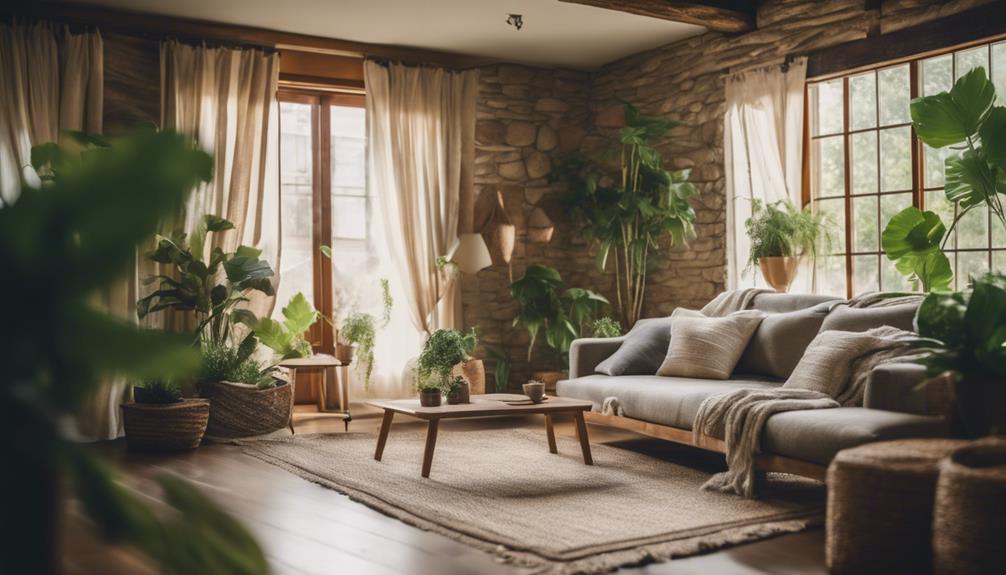
How can you transform your space by integrating natural elements that bring warmth and texture to your design? By thoughtfully incorporating natural materials, you can add texture and create a soothing atmosphere. Here are three easy ways to achieve this:
- Incorporate Wood Accents: Use wooden beams or furniture to introduce a warm, organic texture that enhances your room's aesthetic. Think about reclaimed wood for a rustic touch.
- Add Plants: Integrating plants not only provides organic texture and vibrant color but also breathes life into your space. Consider seasonal arrangements to keep things fresh and dynamic throughout the year.
- Use Stone or Brick Elements: By adding stone or brick, you can introduce coarse textures that lend a rustic feel, harmonizing beautifully with both modern and traditional designs.
Layering for Depth

Building on the warmth created by natural elements, layering different textures in your space can add depth and visual interest that transforms the overall design. By mixing soft fabrics like velvet with hard materials such as wood or metal, you create contrasts that enhance your room's feel.
To effectively layer textures, consider the following elements:
| Layering Technique | Description |
|---|---|
| Rugs | Use multiple sizes and patterns to define areas and add dimension. |
| Throw Pillows | Incorporate diverse shapes and fabric types for an inviting seating area. |
| Wall Treatments | Layer textured wallpaper with framed art to add richness. |
| Decor Arrangements | Vary heights with stacked books or plants on stands to create visual movement. |
| Accent Pieces | Combine different elements like vases and sculptures for added intrigue. |
These layering techniques not only add texture but also create a dynamic environment, encouraging interaction and comfort. By thoughtfully combining these different elements, you can easily elevate your space, making it feel more inviting and visually interesting.
Practical Texture Tips
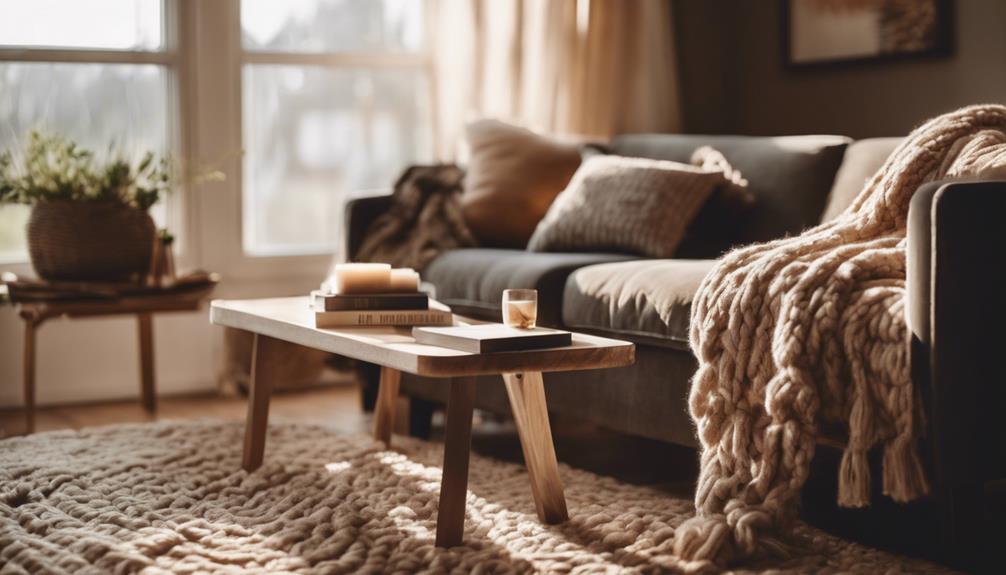
To create a cozy atmosphere, you can layer textiles strategically, mixing chunky blankets with soft pillows for added comfort.
Don't forget to incorporate natural elements like plants or woven materials to bring an organic touch to your space.
These practical texture tips will instantly elevate the visual appeal of any room.
Layering Textiles Strategically
Layering textiles can transform any room into a cozy haven, inviting warmth and depth through a careful mix of fabrics, patterns, and textures. By strategically layering, you not only enhance the visual interest of your home decor but also create a space that feels inviting and comfortable.
Here are three effective ways to layer textiles in your space:
- Throw Pillows & Blankets: Combine cotton, linen, and velvet in your throw pillows and blankets. This mix adds richness and texture, making your seating area more inviting.
- Rug Layering: Use a plush area rug over a flatweave one. This layering technique enhances visual interest while defining areas, especially in open floor plans.
- Window Treatments: Pair sheer linen curtains with heavier velvet drapes. This combination creates depth and dimension, elevating your window treatments and overall aesthetic.
Experimenting with different patterns and colors can further enrich your decor. Mixing stripes, florals, or geometric designs within a cohesive palette adds dynamic layers without overwhelming the space, making your home feel even cozier.
Incorporate Natural Elements
Embracing natural elements can elevate your space's texture and warmth, seamlessly complementing the layered textiles you've already incorporated. Start with wood accents, like exposed beams or rustic furniture. These add a cozy feel and a natural texture that enriches your overall aesthetic.
Consider incorporating stone materials, such as a brick accent wall or slate tiles. These surfaces introduce a coarse texture, creating visual interest and depth in your design.
Next, don't overlook the power of plants. Adding greenery enhances organic texture while infusing your space with vibrant colors, making the room feel inviting. Choose a variety of plants to create different layers of texture, ensuring a lively atmosphere.
Additionally, think about using materials like bamboo or wicker for furniture or decor items. These elements evoke a tropical vibe and offer unique textures that contrast beautifully with other components in the room.
Remember, seasonal changes in your plants can provide dynamic decor options, allowing for revitalizing updates that enhance texture and visual appeal throughout the year.
Frequently Asked Questions
How Do You Add Depth to a Room?
To add depth to a room, mix various textiles like velvet and linen, incorporate textured wall treatments, layer rugs, combine different furniture styles, and use diverse lighting sources for a dynamic atmosphere that captivates.
How to Get Texture Into a Room?
You can transform your room into a textured wonderland! Mix soft cotton with plush velvet, layer rugs over hardwood, and sprinkle in vibrant plants. These elements create a cozy, inviting atmosphere that'll leave everyone in awe.
What Does Rough Texture Do to a Room?
Rough textures make a room feel warmer and more inviting. They add character, enhance authenticity, and create visual interest. Plus, they help absorb sound, making your space quieter and more comfortable for everyone.
Can You Have Too Much Texture in a Room?
Having too much texture in a room can feel like a chaotic symphony. You need balance; mixing smooth and rough textures creates harmony. Stick to three to five distinct types for a cohesive, inviting space.
Conclusion
So, don't hesitate to plunge into the delightful world of texture!
By blending bold fabrics, creating cohesive color schemes, and incorporating interesting materials, you'll effortlessly enhance your environment.
Remember, layering is the key to a lively, luxurious look.
Embrace eclectic elements and let natural nuances shine through.
With these simple texture tips, you'll transform any space into a stunning sanctuary that speaks volumes about your style and personality.
Happy decorating!

